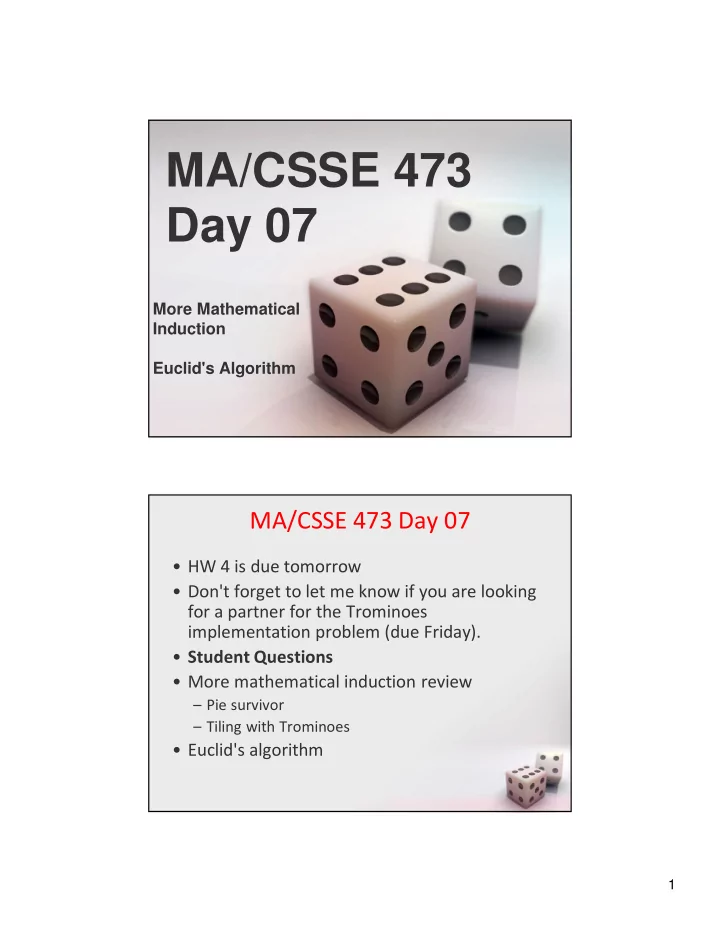

MA/CSSE 473 Day 07 More Mathematical Induction Euclid's Algorithm MA/CSSE 473 Day 07 • HW 4 is due tomorrow • Don't forget to let me know if you are looking for a partner for the Trominoes implementation problem (due Friday). • Student Questions • More mathematical induction review – Pie survivor – Tiling with Trominoes • Euclid's algorithm 1
(More on arithmetic later; this is the review thread) ANOTHER INDUCTION EXAMPLE: ODD PIE FIGHT Another Induction Example • Pie survivor – An odd number of people stand in various positions such that no two distances between people are equal • Each person has a pie • A whistle blows, and each person simultaneously and accurately throws his/her pie at the nearest neighbor – Claim: No matter how the people are arranged, at least one person does not get hit by a pie – Let P(n) denote the statement: "There is a survivor in every odd pie fight with 2n + 1 people" – Prove by induction that P(n) is true for all n ≥ 1 Q1 2
Structural Induction • When a structure is defined recursively, use induction on the structural definition to prove that the property is true for everything covered by the definition • Base case: The base cases in the recursive definition • Induction step: Each recursive part of the definition • We could express it as ordinary induction based on some metric of the structure, but it is often easier to do the induction on the structure itself. Structural Induction Example 1 • Consider the following oversimplified definition of expressions in a programming language: – <Exp> ::= <number> – <Exp> ::= <Exp> <op> <Exp> – <Exp> ::= ( <Exp> ) – <op> ::= + | - | ∗ ∗ | / ∗ ∗ • Prove by structural induction: anything that can be derived from this grammar has an even number of parentheses 3
Structural Induction Example 2 • An Extended Binary Tree (EBT) T is either: – An external node, (designated by a square in diagrams), or – An internal node (designated by a circle in diagrams), and two subtrees (T L and T R ) which are themselves EBTs. This internal node is called the root of the tree • Notation: EN( T ) and IN( T ) denote the number of external nodes and internal nodes, respectively, in the Extended Binary Tree T . Proof is on an earlier ICQ • Prove by structural induction: solution In every EBT T , EN( T ) = IN( T ) + 1 Modular Exponentiation Euclid's Algorithm BACK TO ARITHMETIC THREAD 4
Modular Exponentiation Algorithm • Let n be the maximum number of bits in x, y, or N • The algorithm requires at most ___ recursive calls • Each call is Ѳ( ) • So the overall algorithm is Ѳ( ) Q2-4 Modular Exponentiation Algorithm • Let n be the maximum number of bits in x, y, or N • The algorithm requires at most n recursive calls • Each call is Ѳ( n 2 ) • So the overall algorithm is Ѳ( n 3 ) 5
Euclid's Algorithm: the problem • One of the oldest known algorithms (about 2500 years old) • The problem: Find the greatest common divisor (gcd) of two non-negative integers a and b. • The approach you learned in grade school: – Completely factor each number – find common factors (with multiplicity) – multiply the common factors together to get the gcd • Factoring is hard! • Simpler approach is needed Euclid's Algorithm: the basis • Based on the following rule: – If x and y are positive integers with x ≥ y, then gcd(x, y) = gcd(y, x mod y) • Proof of Euclid's rule: – It suffices to show the simpler rule gcd(x, y) = gcd(y, x - y) since x mod y can be obtained from x and y by repeated subtraction – Any integer that divides both x and y must also divide x – y, so gcd(x, y) ≤ gcd(y, x – y) – Any integer that divides both y and x - y must also divide y, so gcd(y, x-y) ≤ gcd(y, x) 6
Euclid's Algorithm: the algorithm • Example: euclid(60, 36) • Does the algorithm work? • How efficient is it? Q5 Euclid's Algorithm: the analysis • Lemma: If a ≥ b , then a % b < a /2 • Proof – If b ≤ a /2, then a % b < b ≤ a /2 – If b > a /2, then a % b = a – b < a /2 • Application – After two recursive calls, both a and b are at most half of what they were, (i.e. reduced by at least 1 bit) – Thus if a and b have n bits, at most 2n recursive calls are needed. – Each recursive call involves a division, Ѳ(n 2 ) – Entire algorithm is Ѳ(n 3 ) 7
gcd and linear combinations • Lemma: If d divides both a and b , and d = a x + b y for some integers x and y, then d = gcd( a , b ) • Proof – By the first of the two conditions, d is a common divisor of a and b . It cannot exceed the greatest common divisor, so d ≤ gcd( a , b ) – gcd( a , b ) is a common divisor of a and b , so it must divide a x + b y = d . Thus gcd( a , b ) ≤ d – Putting these together, gcd( a , b ) = d • If we can supply the x and y as in the lemma, we know that d is the gcd. • It turns out that a simple modification of Euclid's algorithm will calculate the x and y. Q6 8
Recommend
More recommend